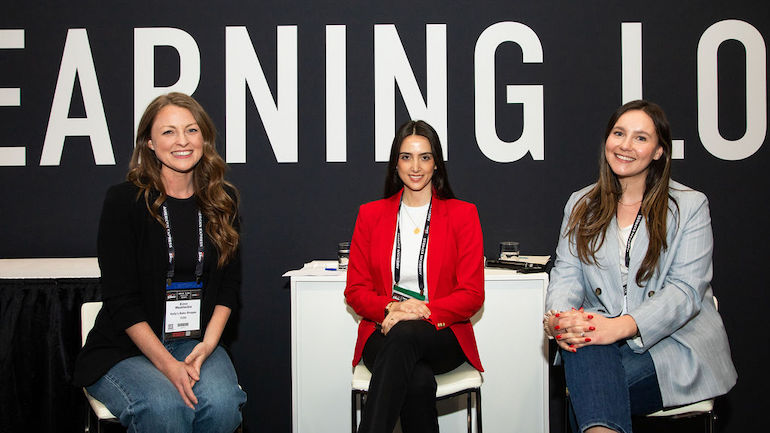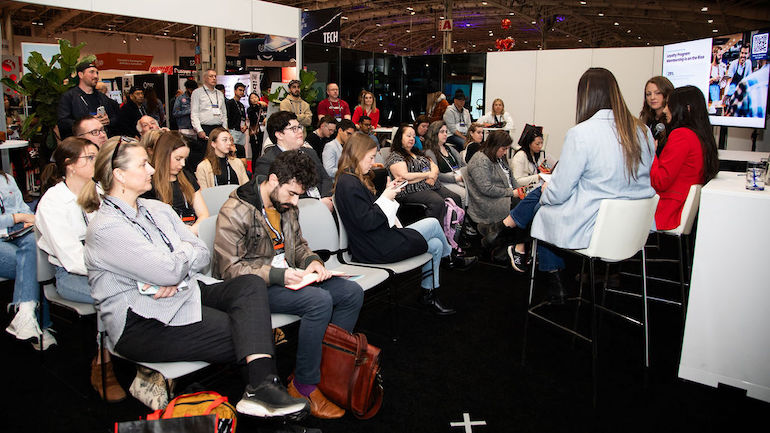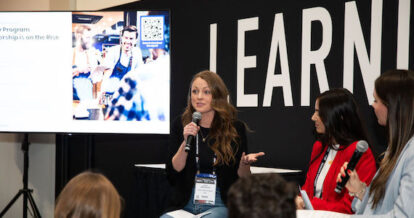Restaurant loyalty programs aren’t just trendy technology, they’re critical to running a financially sustainable business. Why? Because loyalty program members make up a significant portion of lucrative repeat customers.
While traditional loyalty program models are associated with freebies that cut into profits, there are plenty of ways to structure a contemporary loyalty program that gives members value without eating into your bottom line. To show how it can be done, we’re sharing restaurant loyalty programs ideas from TouchBistro’s panel at the 2024 Restaurants Canada Show with experts from Kelly’s Bake Shoppe and z-teca Mexican Eatery, alongside findings from TouchBistro’s 2024 Canadian Diner Report.
Keep reading to learn:
- What restaurant customer loyalty programs look like in 2024
- 3 ways to offer value through your loyalty program (with restaurant loyalty programs examples)
- Tips and strategies from two restaurants that have been there and done that

What Restaurant Loyalty Programs Look Like Now
According to TouchBistro’s 2024 Canadian Diner Trends Report, loyalty program membership is on the rise. In fact, 29% of Canadian diners are currently part of a loyalty program, which is up 6% from two years ago. And, of those memberships, 82% are for quick-service restaurants.
In particular, Canadian Millennials are the most likely to be a part of restaurant loyalty programs. Thirty-eight percent are members of a loyalty program, and one in five members engage with one of these programs daily.
Not only is this audience growing, but it’s also among the most lucrative. Canadian loyalty program members frequent restaurants more often than the general public, which makes them consistent repeat guests. In fact, one in three members dine out at least once a week, which is 8% more than the general population. And, four in 10 loyalty program members order takeout or delivery at least once a week (9% more than the general population).
In part, this enthusiasm for restaurant reward programs is driven by the current period of high inflation, which is making Canadians more cost-conscious than ever before. In fact, 30% of Canadians surveyed in TouchBistro’s report say that menu price increases would significantly impact their decisions to dine at a restaurant. And nearly a quarter of respondents said they can’t absorb any further menu price increases at all.
While inflation has decelerated in Canada over the past year, it’s clear that consumers are still feeling the effects of cost-of-living increases. As a result, their appetite for menu price hikes has evaporated and now they’re on the hunt for value for their money, which is where loyalty programs come in.

3 Ways Restaurant Loyalty Programs Can Offer Value in 2024 (With Restaurant Loyalty Program Examples)
So, the question is: how can restaurant loyalty programs offer cost-sensitive customers value in 2024 without eating into their bottom lines? Fortunately, there are lots of ways restaurateurs can do this and Kelly’s Bake Shoppe and z-teca are two independent operators leading the charge. Here are three proven solutions that experts from these businesses have implemented that you can apply to your restaurant today.
1. Leverage Data to Inform Rewards
One way restaurants can offer loyalty program members value without resorting to freebies or heavy discounts is with personalization. Nearly a third of Canadian diners want personalized offers – a figure that jumps to 39% among Gen Z diners.
Fortunately, personalization is incredibly easy to do now with a customer relationship management (CRM) system, which is something that’s built into most loyalty software. According to TouchBistro’s report, 66% of Canadians want to see offers based on past order history and 46% want to see offers based on personal details like their birthday – all of which is data you already have if you’re using a loyalty CRM.
Just take the example of Canadian QSR chain z-teca Mexican Eatery, which uses CRM data regularly to determine which kinds of loyalty program offers will be most appealing to customers at different locations.
As Z-teca’s Marketing and Communications Director Madeline Sarracini explains, the brand’s suburban locations are “typically anchored in big shopping centers, so those stores are more family oriented. The check average is higher and they activate more in the evening.”
As a result, z-teca sends suburban loyalty program members family-friendly offers later in the day. At the restaurant’s urban locations, which are based in large office towers in downtown Toronto, busy professionals are the target of loyalty offers.
“Folks have a little bit more of a discretionary spend there, so those are the areas where they are opting in for extra protein, for example. A promo that we just ran was based off of insights from our CRM, which showed us that chicken bowls – by a landslide – are a top performer at many of our downtown stores. So when we think about offering any sort of loyalty, we’re going to lead with that,” Madeline says.
Meanwhile, in Burlington, Ontario, gluten-free and vegan bakery Kelly’s Bake Shoppe uses loyalty program data and insights to increase sales during slow times.
“Being a bakery, we’re busy Valentine’s Day, Easter, Mother’s Day – all those really big holidays. So for us, we’ve put in programs like double the points on Tuesdays to drive traffic on what would otherwise be a quieter day of the week for us,” says Erinn Weatherbie, who co-founded the bakery with her mom, Kelly.
Leveraging data to customize their loyalty programs has been a lucrative tactic for both Kelly’s and z-teca.
2. Offer Value in the Form of Flexibility
So, what do customers want… what do they really, really want from loyalty programs? Qualitative findings from TouchBistro’s Canadian Diner Trends Report revealed that diners crave choice and flexibility. Not only does flexibility make programs more appealing, but it also increases the “perception” of value without hurting your bottom line.
In other words, instead of adding more rewards, consider offering flexibility in how diners can redeem their points. Madeline suggests putting your customers first to maximize value.
“Folks spend their discretionary income with us. How can we, in turn, better serve them? What we’re seeing is that customers really want to make sure that the money that they are spending is serving them back,” she says.
Similarly, by putting herself in customers’ shoes, Erinn realized she needed to make Kelly’s Bake Shoppe’s loyalty program more accessible to all customers, no matter what kinds of sweet treats they come in for. In the past, customers could only earn a free cookie or cupcake after a dozen purchases of that same item.
But since implementing TouchBistro Loyalty programs, Kelly’s now offers “a spend-based loyalty program and we’re finding it’s just more inclusive to all of our customers. So customers who come in for a muffin, a donut, or maybe some ice cream [can also accumulate points and earn a reward of their choice]. We’re not just kind of restricting things to be cupcakes and cookies specifically, it’s the entire business as a whole,” Erinn says.
Another way to give restaurant reward program members more flexibility is to reward them with customization options. For instance, you could give customers the option to put their points toward flavored syrups or cold foam to craft their perfect beverage.
By adding flexibility and choice to your loyalty program, you can make customers feel like they’re receiving added value without sacrificing your bottom line. That’s what we call a win-win situation!
3. Zero in on Your “Power Users”
Our last restaurant loyalty program idea is to pay close attention to your “power users.” A study by Paytronix found that half of all loyalty visits come from the most active 10% of members, which means most restaurants have a core group of really loyal (and lucrative) customers that you can tap into.
Use CRM data to identify your power users and begin studying their dining habits to better understand what they want. Then, segment this group and make adjustments to your loyalty program (and marketing efforts) to make it more enticing to those customers who are the most likely to come back for repeat visits.
With the help of z-teca’s data from TouchBistro Loyalty and Marketing, Madeline has identified power users who have lunch at the restaurant every day and wants to thank them for their repeat business.
“They’ve amassed all these loyalty points. So, what we’re planning for this year is to make that human connection with them. Just reaching out, whether it’s through a DM, through the loyalty app, or over email, to say, ‘Hey, we noticed you visit us four times a week. We appreciate your business. Here’s a coupon. Here’s a digital gift card.’ It really goes a long way,” Madeline says.
Another way z-teca is planning on thanking power users is by “entering our super customers twice in giveaways, for things like laptops and Dyson vacuums, when traditionally other customers would just be entered once,” she says.
Kelly’s Bake Shoppe also uses CRM data to show their VIPs some love. The bakery has identified 50 loyalty program members who spend between $50 and $75 on average per visit and sends them coupons they can use within seven days.
Erinn says this reward “creates that sense of urgency to actually drive traffic, and it gives customers immense value. It’s a beautiful reward to just say, ‘thank you. We appreciate your business, sincerely.’”
It’s clear that despite their price sensitivity, diners want to see more restaurant loyalty programs. For restaurants, this is an especially valuable audience to target. The key to making a loyalty program work for your restaurant is to make data-driven decisions, think about choice as a reward, and make power users feel like VIPs.
For more insights into what customers want, download our 2024 Canadian Diner Trends Report. And, if you want to start maximizing the value of each customer, check out TouchBistro Loyalty today.
Sign up for our free weekly TouchBistro Newsletter





